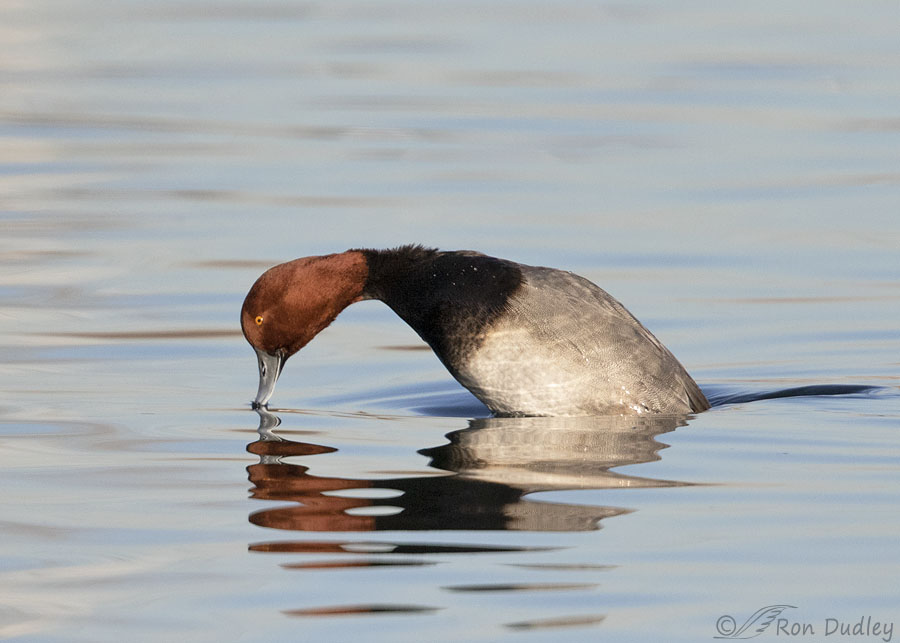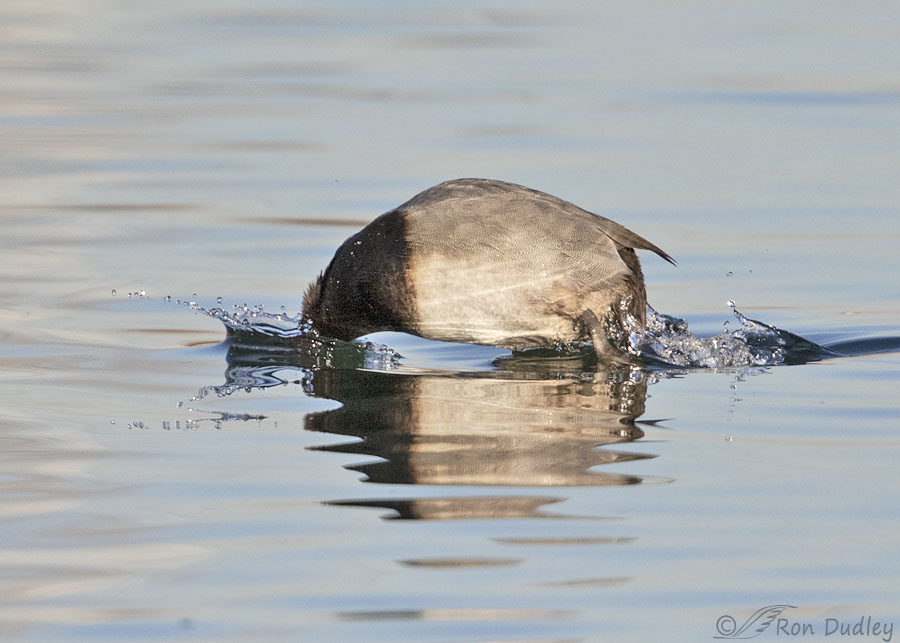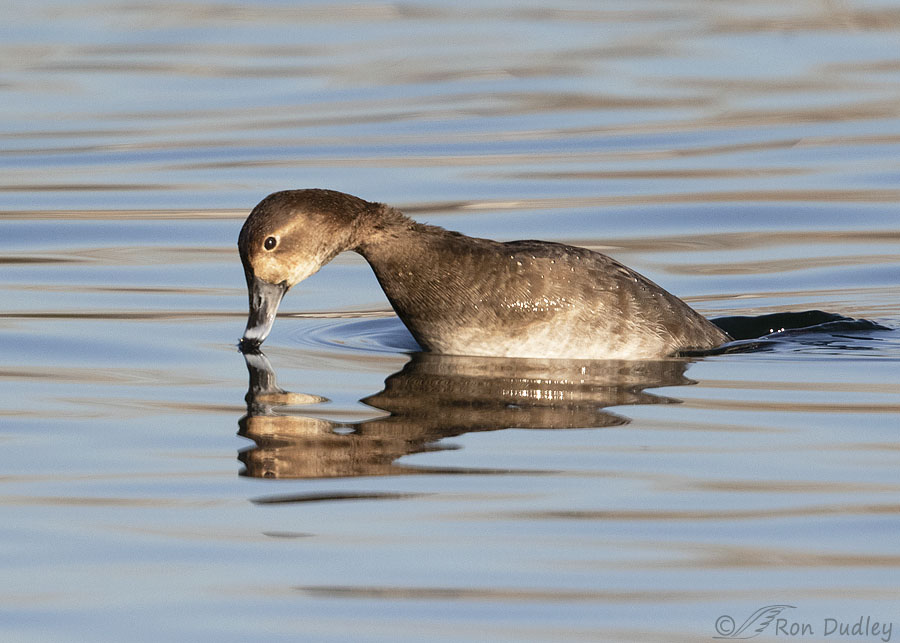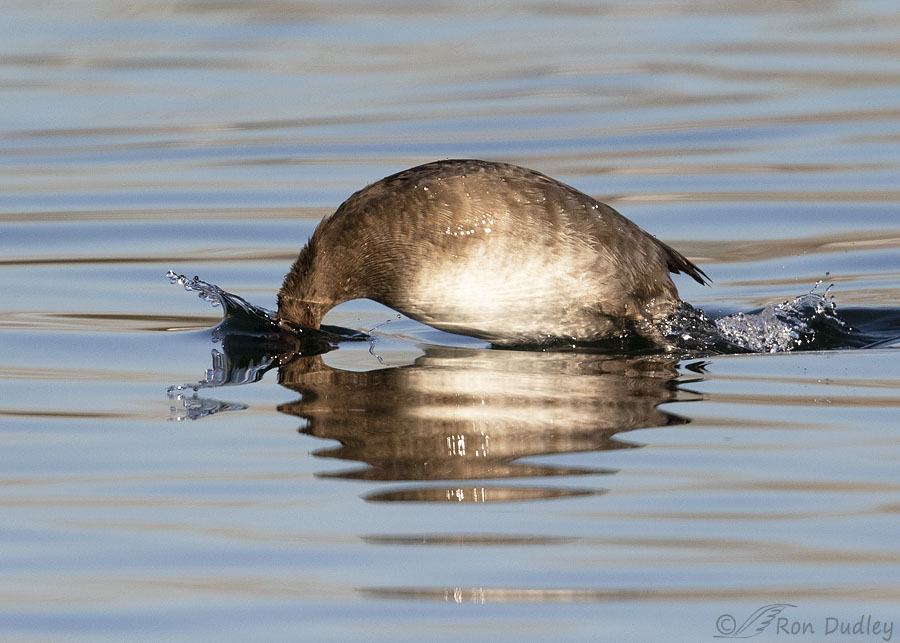Choreography with a delay.

1/8000, f/6.3, ISO 800, Canon 7D Mark II, Canon EF 500mm f/4L IS II USM + EF 1.4 III Extender, not baited, set up or called in
Twelve days ago I spent some time photographing several duck species as they were diving for food. My goal was to capture them just before their eyes entered the water. That goal was never perfectly met but I like the position of this drake Redhead better than having his eyes already underwater.
Just before I took this photo the duck moved into an area of much brighter water which caused my shutter speed to skyrocket to 1/8000 (I shoot in aperture priority). But I’d rather err on the side of too much SS than too little.

1/8000, f/6.3, ISO 800, Canon 7D Mark II, Canon EF 500mm f/4L IS II USM + EF 1.4 III Extender, not baited, set up or called in
The next shot in the burst caught him with his head and neck submerged and his body pretty much parallel to the water’s surface.

1/6400, f/6.3, ISO 800, Canon 7D Mark II, Canon EF 500mm f/4L IS II USM + EF 1.4 III Extender, not baited, set up or called in
There was a hen Redhead very close to the drake and immediately after he dived I barely had time to get her in my viewfinder before she followed suit. My first shot caught her in almost exactly the same diving position I’d captured the drake in and the same could be said for…

1/6400, f/6.3, ISO 800, Canon 7D Mark II, Canon EF 500mm f/4L IS II USM + EF 1.4 III Extender, not baited, set up or called in
my second shot in the burst.
If you compare the corresponding photos in the two short sequences they’re nearly identical, save for the sex of the ducks. The two dives occurred within seconds of each other, my shooting angles on both ducks were very similar and both ducks were the same distance from me so all four photos were cropped exactly the same amount (7.5 MP out of 20 MP).
Much ado about nothing I suppose but when stuff like this happens I sit up and take notice. If nothing else it’s a series of unusual coincidences so it amuses me.
Ron


The new ballet: Duck Lake. This series of 4 shots would make a lovely wall enhancement.
This series of 4 shots would make a lovely wall enhancement.
What’s good for the goose is good for the gander. Okay, they’re ducks, but you get the point.
Despite not having achieved your elusive sought after diving shot you are entertaining us with your quest. “It’s the journey, not the destination.” So far, anyway.
Good point, Lyle. It is indeed the journey.
You all have the same timing.
Yup.
Bird choreography often fascinates me. Awes me. And somedays frustrates me.
They seem to know to the millisecond just how to avoid the shot I would love to take (though my reflexes are slow). Dammit.
Ha, when that happens I bet we both do better than just “dammit”. I know I do.
More beautiful color reflections in the water.
Thanks, Sallie.
I like the photos AND the consistency of your dive shots. Just faster than the shutter speed it seems – interesting and, I’m sure, a bit frustrating since it’s obviously not your reflexes. Suspect tail down gives them a “boost” in the direction they want to go. Beautiful birds and shots!
Thank you, Judy.
Much ado about nothing, but lots of fun for sure. I really like the first one best. Catching them just before the eye goes under is all about microseconds. Of course you could hang around all morning and take 400 shots and then you would surely get a few to meet that requirement.
I was just taking shots of a Goldeneye male doing that yesterday, but was just taking shots – no goal in mind.
Everett, sometimes the “goal” is something we don’t even think about before we capture it.
What a terrific series of photographs, Ron!
It’s “unusual coincidences” such as these which keep some of us heading out the door again and again.
Yup, for me that’s definitely part of it, Wally. Thanks.
I think it says a lot for your amazing sense of timing, too, to have caught both of them at precisely the same points. Bravo!
Alison, that “sense of timing” is largely due to two things I can’t control – the speed of my reflexes (which seems to be very consistent) and the burst rate of my camera.
It’s interesting how diving ducks press down with their tail to aid in the dive. The first two images in the sequence demonstrate it well..
I agree, Stephen. And they flare their tail just prior to diving to make it more efficient.